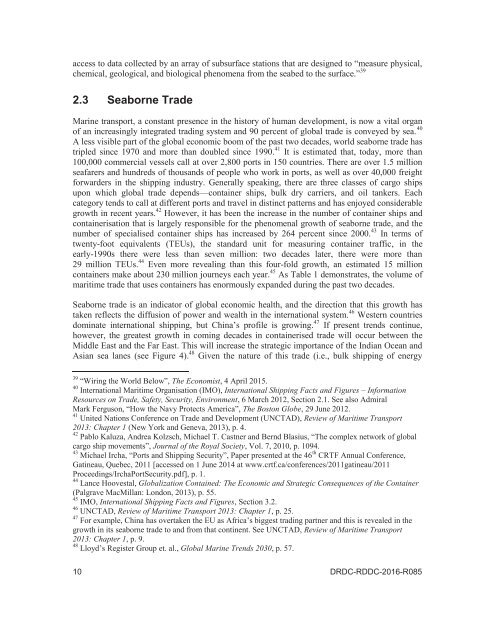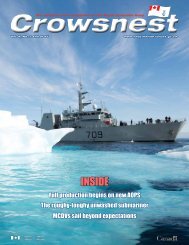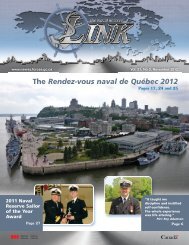Create successful ePaper yourself
Turn your PDF publications into a flip-book with our unique Google optimized e-Paper software.
access to data collected by an array <strong>of</strong> subsurface stations that are designed to “measure physical,<br />
chemical, geological, <strong>and</strong> biological phenomena from <strong>the</strong> seabed to <strong>the</strong> surface.” 39<br />
2.3 Seaborne Trade<br />
Marine transport, a constant presence in <strong>the</strong> history <strong>of</strong> human development, is now a vital organ<br />
<strong>of</strong> an increasingly integrated trading system <strong>and</strong> 90 percent <strong>of</strong> global trade is conveyed by sea. 40<br />
A less visible part <strong>of</strong> <strong>the</strong> global economic boom <strong>of</strong> <strong>the</strong> past two decades, world seaborne trade has<br />
tripled since 1970 <strong>and</strong> more than doubled since 1990. 41 It is estimated that, today, more than<br />
100,000 commercial vessels call at over 2,800 ports in 150 countries. <strong>The</strong>re are over 1.5 million<br />
seafarers <strong>and</strong> hundreds <strong>of</strong> thous<strong>and</strong>s <strong>of</strong> people who work in ports, as well as over 40,000 freight<br />
forwarders in <strong>the</strong> shipping industry. Generally speaking, <strong>the</strong>re are three classes <strong>of</strong> cargo ships<br />
upon which global trade depends—container ships, bulk dry carriers, <strong>and</strong> oil tankers. Each<br />
category tends to call at different ports <strong>and</strong> travel in distinct patterns <strong>and</strong> has enjoyed considerable<br />
growth in recent years. 42 However, it has been <strong>the</strong> increase in <strong>the</strong> number <strong>of</strong> container ships <strong>and</strong><br />
containerisation that is largely responsible for <strong>the</strong> phenomenal growth <strong>of</strong> seaborne trade, <strong>and</strong> <strong>the</strong><br />
number <strong>of</strong> specialised container ships has increased by 264 percent since 2000. 43 In terms <strong>of</strong><br />
twenty-foot equivalents (TEUs), <strong>the</strong> st<strong>and</strong>ard unit for measuring container traffic, in <strong>the</strong><br />
early-1990s <strong>the</strong>re were less than seven million: two decades later, <strong>the</strong>re were more than<br />
29 million TEUs. 44 Even more revealing than this four-fold growth, an estimated 15 million<br />
containers make about 230 million journeys each year. 45 As Table 1 demonstrates, <strong>the</strong> volume <strong>of</strong><br />
maritime trade that uses containers has enormously exp<strong>and</strong>ed during <strong>the</strong> past two decades.<br />
Seaborne trade is an indicator <strong>of</strong> global economic health, <strong>and</strong> <strong>the</strong> direction that this growth has<br />
taken reflects <strong>the</strong> diffusion <strong>of</strong> power <strong>and</strong> wealth in <strong>the</strong> international system. 46 Western countries<br />
dominate international shipping, but China’s pr<strong>of</strong>ile is growing. 47 If present trends continue,<br />
however, <strong>the</strong> greatest growth in coming decades in containerised trade will occur between <strong>the</strong><br />
Middle East <strong>and</strong> <strong>the</strong> Far East. This will increase <strong>the</strong> strategic importance <strong>of</strong> <strong>the</strong> Indian Ocean <strong>and</strong><br />
Asian sea lanes (see Figure 4). 48 Given <strong>the</strong> nature <strong>of</strong> this trade (i.e., bulk shipping <strong>of</strong> energy<br />
39 “Wiring <strong>the</strong> World Below”, <strong>The</strong> Economist, 4 April 2015.<br />
40 International <strong>Maritime</strong> Organisation (IMO), International Shipping Facts <strong>and</strong> Figures – Information<br />
Resources on Trade, Safety, Security, <strong>Environment</strong>, 6 March 2012, Section 2.1. See also Admiral<br />
Mark Ferguson, “How <strong>the</strong> Navy Protects America”, <strong>The</strong> Boston Globe, 29 June 2012.<br />
41 United Nations Conference on Trade <strong>and</strong> Development (UNCTAD), Review <strong>of</strong> <strong>Maritime</strong> Transport<br />
2013: Chapter 1 (New York <strong>and</strong> Geneva, 2013), p. 4.<br />
42 Pablo Kaluza, Andrea Kolzsch, Michael T. Castner <strong>and</strong> Bernd Blasius, “<strong>The</strong> complex network <strong>of</strong> global<br />
cargo ship movements”, Journal <strong>of</strong> <strong>the</strong> Royal Society, Vol. 7, 2010, p. 1094.<br />
43 Michael Ircha, “Ports <strong>and</strong> Shipping Security”, Paper presented at <strong>the</strong> 46 th CRTF Annual Conference,<br />
Gatineau, Quebec, 2011 [accessed on 1 June 2014 at www.crtf.ca/conferences/2011gatineau/2011<br />
Proceedings/IrchaPortSecurity.pdf], p. 1.<br />
44 Lance Hoovestal, Globalization Contained: <strong>The</strong> Economic <strong>and</strong> Strategic Consequences <strong>of</strong> <strong>the</strong> Container<br />
(Palgrave MacMillan: London, 2013), p. 55.<br />
45 IMO, International Shipping Facts <strong>and</strong> Figures, Section 3.2.<br />
46 UNCTAD, Review <strong>of</strong> <strong>Maritime</strong> Transport 2013: Chapter 1, p. 25.<br />
47 For example, China has overtaken <strong>the</strong> EU as Africa’s biggest trading partner <strong>and</strong> this is revealed in <strong>the</strong><br />
growth in its seaborne trade to <strong>and</strong> from that continent. See UNCTAD, Review <strong>of</strong> <strong>Maritime</strong> Transport<br />
2013: Chapter 1, p. 9.<br />
48 Lloyd’s Register Group et. al., Global Marine Trends 2030, p. 57.<br />
10 DRDC-RDDC-2016-R085




